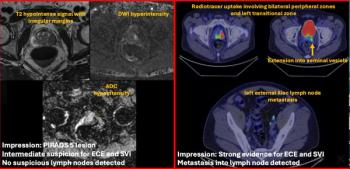
Osteopoikilosis
A 58-year-old man with a chief complaint of diarrhea underwent radiographic examination of the chest and abdomen. Images showed numerous well-defined, bilateral, ovoid sclerotic foci within the proximal femurs and the acetabulum.
CLINICAL HISTORY
A 58-year-old man with a chief complaint of diarrhea underwent radiographic examination of the chest and abdomen.
FINDINGS
Figure 1. Numerous well-defined, bilateral, ovoid sclerotic foci within the epiphysis and metaphysis of the proximal femurs and within the acetabulum. Figure 2. Multiple well-defined, bilateral, ovoid, sclerotic foci within the epiphysis and metaphysis of the proximal humerus and within the glenoid.
DIAGNOSIS
Osteopoikilosis
DIFFERENTIAL DIAGNOSIS
The top differential diagnosis includes osteoblastic metastasis, mastocytosis, tuberous sclerosis, and synovial chondromatosis.
DISCUSSION
Osteopoikilosis (osteopathia condensans disseminate) is a rare osteosclerotic dysplasia characterized by multiple discrete round or ovoid densities in cancellous bone. The diagnosis is usually made incidentally on radiographs obtained for unrelated complaints. The disorder is seen in both male and female patients with both inherited and sporadic cases reported.
Radiographic findings are diagnostic and consist of numerous oval or round 2 to 10-mm sclerotic foci that are symmetrically distributed within the metaphysis and epiphysis of the long bones. The lesions appear in childhood, rarely before the third year of life, and persist thereafter. The major sites of involvement include long tubular bones, carpal bones, tarsal bones, pelvis, sacrum, and scapulae. The ribs, clavicle, spine, and skull are typically spared.
Osteopoikilosis has been reported to occur in association with connective tissue nevi called dermatofibrosis lenticularis disseminata, or Buschke-Ollendorff syndrome. Additionally, there is an association with keloid formation of tuberous sclerosis, scleroderma, and other osteosclerotic skeletal disorders. Complications are extremely rare, with a single case report of osteosarcoma and chondrosarcoma in two different patients with osteopoikilosis. Submitted by Andrew Allmendinger, D.O., and Robert Perone M.D., St. Vincent's Medical Center, New York, NY.
BIBLIOGRAPHY
Resnick D, Kransdorf MJ. Enostosis, hyperostosis and periostitis. Bone and joint imaging, 3rd ed. Philadelphia: Elsevier Saunders, 2005:1425.
Khot R, Sikarwar JS, Gupta RP. Osteopoikilosis: a case report. Ind J Radiol Imag 2005;15: 4453-4454.
Benli IT, Akalin S, Boysan E. Epidemiological, clinical and radiological aspects of osteopoikilosis. J Bone Joint Surg 1992;74-B(4):504-506.
Newsletter
Stay at the forefront of radiology with the Diagnostic Imaging newsletter, delivering the latest news, clinical insights, and imaging advancements for today’s radiologists.




























